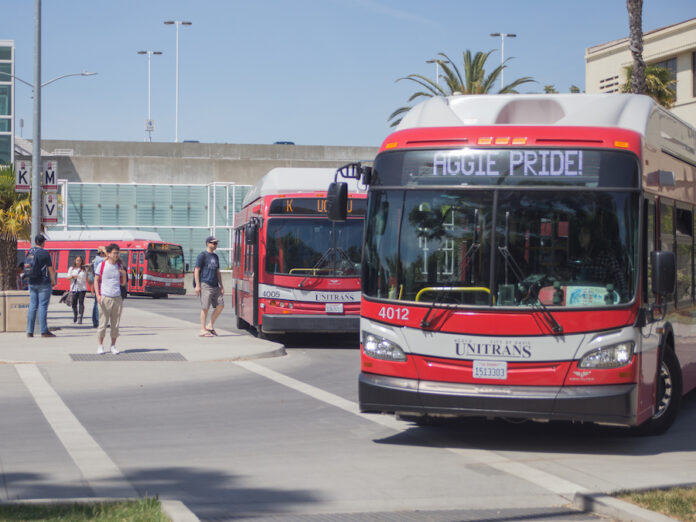The transportation service requires 50 hours more than bus industry’s requirement of 80-100 hours of driver training
On Nov. 8, 2019 around 7:30 p.m., a Unitrans bus stopped at the Oak and Russell stoplight, only to be rear ended by a drunk driver who fled the scene. The suspect was identified by police as 21-year-old Noah Amerault. Fortunately, no members in either of the vehicles were harmed. Amerault was later arrested.
This is not the first collision the transportation service has experienced, with another notable event occurring in April 2019 when a high-speed pursuit led a suspect to crash into a Unitrans bus.
The Unitrans bus system was founded in 1972 and currently boasts 20 routes and 49 buses. In light of these recent accidents, and given the fact that Unitrans is an entirely student-run and student-driven service, some may have safety concerns. Jeffrey Flynn, Unitrans’s general manager, however, explained that the organization does not take safety lightly.
In fact, the Unitrans training program is highly extensive, taking 50 hours longer to complete than the industry standard of 80-100 hours for bus driver training and 10 times longer than the state-mandated 15 hours.
Moreover, Unitrans experiences both minor and major accidents every year — but its numbers are lower than other outside public bussing systems, especially taking into consideration the number of people it serves each day.
Major accidents, defined as accidents that require a vehicle to be towed or passengers to be transported to the hospital, happen on average two times a year, and passengers riding Unitrans sustain close to zero injuries.
“I’m really proud of our training program and how our drivers operate our buses,” Flynn said. “Safety is the number one priority of Unitrans. We service 23,000 people a day, almost incident free.”
In the 2018-19 fiscal year, Unitrans met the City of Davis’ short-range transit plan’s safety objective, measured by miles between preventable accidents. The standard was 100,000 miles between accidents — and Unitrans exceeded that with 266,336 miles. Another measure takes into consideration injuries per 100,000 boardings. The standard is one, or less than one, and Unitrans’s injuries per 100,000 boardings is less than one.
Haley Schrock, a fourth-year animal science major and Unitrans worker, said drivers avoid making “illegal turns,” which are “turns we know we can’t make.”
“We know that 100% of [the buses] can’t make them, [so] our routes avoid these turns,” Schrock said. “We also do mirror checks every four to eight seconds because we need to see what’s going on around us at all times. When we stop, we keep a MINI Cooper-sized car between us and the car in front of us. This way, we can move in case the car in front of us breaks down. We are also taught to scan […] all the time — our heads should be moving the whole time instead of just staring in one place.”
Schrock is also a Unitrans route trainer. She tells her trainees to act like “they’re always going to be cut off” and to drive defensively.
Drivers are also extensively trained on what to do in the case of an accident and have special protocols to follow if an incident were to occur. Anthony Andrade, a fourth-year animal science major and Unitrans supervisor, explained that no matter the severity, all incidents are treated with the same level of gravity.
“All accidents have the same procedure, no matter how minor or major,” Andrade said. “The first thing you do is stop and pull over. Then […] check on our passengers [and] check on the other parties involved. If [the bus] was the only vehicle involved, like you popped a curb, then check for damages. But if there were other vehicles involved, we’d check on that person, make sure they’re okay. The police can be called. We usually call police anyways. If we need an ambulance, the driver should call them. The last step is to call the supervisor and let them know what happened so they can head out there.”
There are mandatory safety meetings every quarter for drivers, to refresh and update them on safety protocols.
“As a driver, you receive a lot of training, but in the moment, when something happens, you forget because you’re really nervous about what happened,” Andrade said. “Every bus has a print out of step-by-step what to do in an accident in case you forget or to make sure you do everything right. I feel very confident responding in an accident, as a driver.”
Written by: Isabella Beristain and Linh Nguyen — features@theaggie.org




